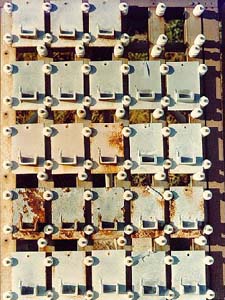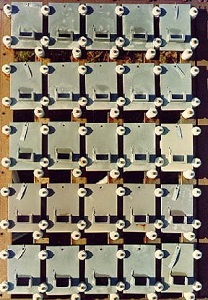
Coatings Data
Coatings and corrosion control test data:
Over the past 60 years KSC has developed many proven methodologies to evaluate and test materials and coatings for use in corrosive environments. Coatings are the primary method of corrosion control for launch structures and equipment at the J.F. Kennedy Space Center. The performance requirements for corrosion control used at NASA for ground equipment are defined in the NASA coating standard, NASA-STD-5008B (Protective Coating of Carbon Steel, Stainless Steel, and Aluminum on Launch Structures, Facilities, and Ground Support Equipment). Conversion coatings and primers, passivation, and corrosion resistant alloy selection are most often used to protect flight hardware depending on the substrate type and configuration. The corrosion control requirements for flight hardware are found in NASA-STD-6012 (Corrosion Protection for Flight Hardware).
https://standards.nasa.gov/standard/nasa/nasa-std-5008
https://standards.nasa.gov/standard/nasa/nasa-std-6012
NASA-STD-5008B Qualification Testing:
All qualification testing for coatings approved in NASA-STD-5008B are performed at KSC by the Corrosion Engineering Laboratory. KSC prepares candidate coating test panels in the coatings application laboratory in order to simultaneously evaluate the ease of application and assess of any potential difficulties in applying coatings to real structures. Most coatings are applied to standard flat panels and flat panels with c-channel welds attached. This enables the comparison of results obtained from other tests conducted over the years on similar panels. The c-channel panels test the ease of coating application over weld spatter, on complicated edges, and in crevices that cannot be adequately prepared by blast or other surface preparation techniques. Coatings evaluated according to the requirements in NASA-STD-5008B are generally exposed for 18 months at the beachside test site with the official qualification period of performance of 5 years. Coatings are often left at the beachside test site for many years thereafter to collect more data.
Testing of protective coatings for carbon steel, stainless steel, and aluminum has been an ongoing process for many years at KSC. In 1969, a testing program was initiated to evaluate coatings for the long term protection of carbon steel exposed to a sea coast environment. Both organic and inorganic zinc-rich coatings were applied to test panels and exposed at the KSC Beachside Atmospheric Corrosion Test Site. These panels were evaluated for corrosion after 18 months, 3 years, 5 years, and 10 years of exposure. The results of that study showed that the inorganic zinc-rich coatings displayed excellent corrosion protection, while organic zinc-rich formulations did not perform well. While corrosion is apparent on the organic zinc panels on the left, no corrosion appears on the inorganic zinc panels on the right.


As a result of that study, inorganic zinc-rich coatings with no topcoat were used for many years at KSC for the long-term protection of carbon steel.
In 1981 the Space Shuttle launch system introduced a more aggressive environment to the Kennedy Space Center launch facilities. Exhaust from the solid rocket boosters included small particles of alumina with hydrochloric acid absorbed onto the surface of these particles. The end result of a heavy loft launch was the injection of 70 tons of 0.1M hydrochloric acid into the surrounding local launch environment. Wherever a cloud of this exhaust settled, unprotected zinc coatings were corroded because zinc readily corrodes in contact with acid. No inorganic zinc protective coating systems were immune to this new environment. At this time KSC launched a study of new coatings to resist the more aggressive environment.
At about the same time it became necessary to address new environmental regulations that limited the vapors that evaporate from coatings as they cure. New coating systems with lowered volatile organic compound (VOC) contents were included in a study starting in 1991 and are continuing to this day.